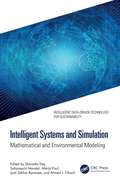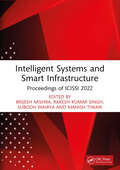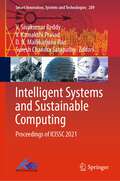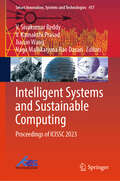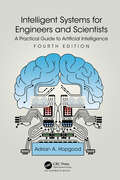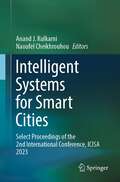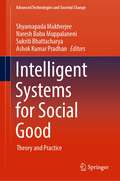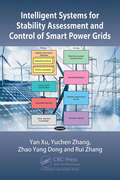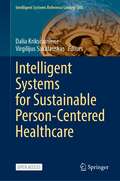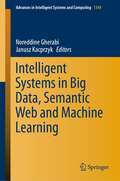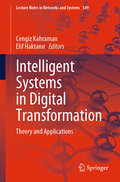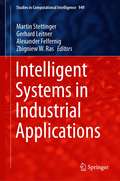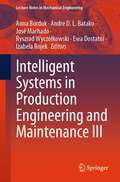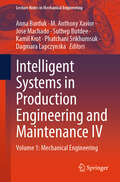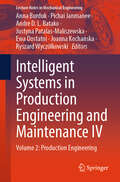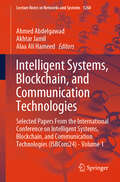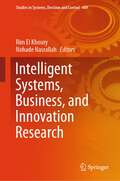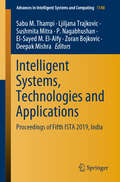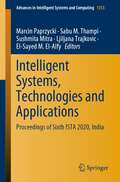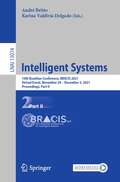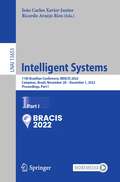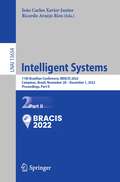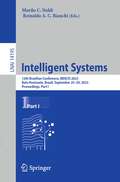- Table View
- List View
Intelligent Systems and Simulation: Mathematical and Environmental Modeling (Intelligent Data-Driven Technology for Sustainability)
by Ahmed J. Obaid Jyoti Sekhar Banerjee Sharadia Dey Sabyasachi Mondal Abhijit PaulThis book covers a wide range of topics such as mathematical modeling, computational methods, simulation techniques in engineering, and their applications in environmental sciences. It begins with an introduction to the fundamental concepts and principles of mathematical modeling with subsequent sections delving into various simulation techniques, including numerical methods, statistical modeling, and bio-mathematical modeling. It also explores the application of these techniques in addressing complex environmental problems.Features: Covers mathematical and computational modeling techniques for simulation in engineering, mathematical, and environmental domains Explores intelligent techniques and simulation methods to enhance accuracy and efficiency in modeling and simulation Includes practical applications and studies that demonstrate the effectiveness of techniques in real-world scenarios Incorporates pertinent newly developed methodologies and applications Discusses CFD software tools like Fortran, MATLAB®, and Mathematics This book is aimed at researchers and graduate students in computer engineering, applied mathematics, and applied ecology.
Intelligent Systems and Smart Infrastructure: Proceedings of ICISSI 2022
by Manish Tiwari Rakesh Kumar Singh Brijesh Mishra Subodh WairyaThis book covers the proceedings of ICISSI 2022 (International Conference on Intelligent Systems and Smart Infrastructure) held at Prayagraj, Uttar Pradesh during April 21–22, 2022. The conference was jointly organised by Shambhunath Institute of Engineering and Technology, Prayagraj UP India, Institute of Engineering and Technology (IET) Lucknow, U.P India, and Manipal University Jaipur, Rajasthan India with an aim to provide a platform for researchers, scientists, technocrats, academicians and engineers to exchange their innovative ideas and new challenges being faced in the field of emerging technologies. The papers presented in the conference have been compiled in form of chapters to focus on the core technological developments in the emerging fields like machine learning, intelligence systems, smart infrastructure, advanced power technology etc.
Intelligent Systems and Sustainable Computing: Proceedings of ICISSC 2021 (Smart Innovation, Systems and Technologies #289)
by Suresh Chandra Satapathy V. Kamakshi Prasad V. Sivakumar Reddy D. N. Mallikarjuna RaoThe book is a collection of best selected research papers presented at the International Conference on Intelligent Systems and Sustainable Computing (ICISSC 2021), held in School of Engineering, Malla Reddy University, Hyderabad, India, during 24–25 September 2021. The book covers recent research in intelligent systems, intelligent business systems, soft computing, swarm intelligence, artificial intelligence and neural networks, data mining & data warehousing, cloud computing, distributed computing, big data analytics, Internet of Things (IoT), machine learning, speech processing, sustainable high-performance systems, VLSI and embedded systems, image and video processing, and signal processing and communication.
Intelligent Systems and Sustainable Computing: Proceedings of ICISSC 2022 (Smart Innovation, Systems and Technologies #363)
by V. Kamakshi Prasad Jiacun Wang V. Sivakumar Reddy Naga Mallikarjuna Rao DasariThis book is a collection of best selected research papers presented at Second International Conference on Intelligent Systems and Sustainable Computing (ICISSC 2022), held in School of Engineering, Malla Reddy University, Hyderabad, India, during December 16–17, 2022. The book covers recent research in intelligent systems, intelligent business systems, soft computing, swarm intelligence, artificial intelligence and neural networks, data mining and data warehousing, cloud computing, distributed computing, big data analytics, Internet of things (IoT), machine learning, speech processing, sustainable high-performance systems, VLSI and embedded systems, image and video processing and signal processing and communication.
Intelligent Systems and Sustainable Computing: Proceedings of ICISSC 2023 (Smart Innovation, Systems and Technologies #417)
by V. Kamakshi Prasad Jiacun Wang V. Sivakumar Reddy Naga Mallikarjuna Rao DasariThis book is a collection of best-selected research papers presented at Third International Conference on Intelligent Systems and Sustainable Computing (ICISSC 2023), held in School of Engineering, Malla Reddy University, Hyderabad, India, during December 22–23, 2023. The book covers recent research in intelligent systems, intelligent business systems, soft computing, swarm intelligence, artificial intelligence and neural networks, data mining and data warehousing, cloud computing, distributed computing, big data analytics, Internet of Things (IoT), machine learning, speech processing, sustainable high-performance systems, VLSI and embedded systems, image and video processing, and signal processing and communication. Chapters 7 and 32 in this book is available open access under a CC BY 4.0 license at link.springer.com.
Intelligent Systems for Engineers and Scientists
by Adrian A. HopgoodThe third edition of this bestseller examines the principles of artificial intelligence and their application to engineering and science, as well as techniques for developing intelligent systems to solve practical problems. Covering the full spectrum of intelligent systems techniques, it incorporates knowledge-based systems, computational intellige
Intelligent Systems for Engineers and Scientists: A Practical Guide to Artificial Intelligence
by Adrian A. HopgoodThe fourth edition of this bestselling textbook explains the principles of artificial intelligence (AI) and its practical applications. Using clear and concise language, it provides a solid grounding across the full spectrum of AI techniques, so that its readers can implement systems in their own domain of interest. The coverage includes knowledge-based intelligence, computational intelligence (including machine learning), and practical systems that use a combination of techniques. All the key techniques of artificial intelligence are explained—including rule-based systems, Bayesian updating, certainty theory, fuzzy logic (types 1 and 2), agents, objects, frames, symbolic learning, case-based reasoning, genetic algorithms and other optimization techniques, shallow and deep neural networks, hybrids, and the Lisp, Prolog, and Python programming languages. The book also describes a wide range of practical applications in interpretation and diagnosis, design and selection, planning, and control. Fully updated and revised, Intelligent Systems for Engineers and Scientists: A practical guide to artificial intelligence, Fourth Edition features: A new chapter on deep neural networks, reflecting the growth of machine learning as a key technique for AI A new section on the use of Python, which has become the de facto standard programming language for many aspects of AI The rule-based and uncertainty-based examples in the book are compatible with the Flex toolkit by Logic Programming Associates (LPA) and its Flint extension for handling uncertainty and fuzzy logic. Readers of the book can download this commercial software for use free of charge. This resource and many others are available at the author’s website: adrianhopgood.com Whether you are building your own intelligent systems, or you simply want to know more about them, this practical AI textbook provides you with detailed and up-to-date guidance.
Intelligent Systems for Smart Cities: Select Proceedings of the 2nd International Conference, ICISA 2023
by Anand J. Kulkarni Naoufel CheikhrouhouThis book presents the select proceedings of the 2nd International Conference on Intelligent Systems and Applications 2023. The theme of this conference is ‘Intelligent Systems for Smart Cities'. It covers the topics of intelligent systems in multiple aspects such as healthcare, supply chain and logistics, smart homes and smart structures, banking and finance, a sustainable environment, social media and cyber security, crime prevention, and disaster management. The book will be useful for researchers and professionals interested in the broad field of artificial intelligence and machine learning.
Intelligent Systems for Social Good: Theory and Practice (Advanced Technologies and Societal Change)
by Naresh Babu Muppalaneni Ashok Kumar Pradhan Shyamapada Mukherjee Sukriti BhattacharyaThis book highlights the connections between two technologies: artificial intelligence (AI) and Internet of things (IoT). It presents the application of these two technologies to solve various societal problems related to healthcare, agriculture, green environment, renewable energies, smart cities, etc. Each chapter in this book presents novel solutions to these problems along with the challenges in the application of AI and IoT to solve them. It discusses the adverse attacks on machine Learning models and how to protect sensitive data over the IoT networks. It also includes the security issues in IoT and their possible solutions.
Intelligent Systems for Stability Assessment and Control of Smart Power Grids: Security Analysis, Optimization, and Knowledge Discovery
by Yan Xu Rui Zhang Zhao Yang Dong Yuchen ZhangPower systems are evolving towards the Smart Grid paradigm, featured by large-scale integration of renewable energy resources, e.g. wind and solar power, deeper participation of demand side, and enhanced interaction with electric vehicles. While these emerging elements are inherently stochastic in nature, they are creating a challenge to the system’s stability and its control. In this context, conventional analysis tools are becoming less effective, and necessitate the use alternative tools that are able to deal with the high uncertainty and variability in the smart grid. Smart Grid initiatives have facilitated wide-spread deployment of advanced sensing and communication infrastructure, e.g. phasor measurement units at grid level and smart meters at household level, which collect tremendous amount of data in various time and space scales. How to fully utilize the data and extract useful knowledge from them, is of great importance and value to support the advanced stability assessment and control of the smart grid. The intelligent system strategy has been identified as an effective approach to meet the above needs. This book presents the cutting-edge intelligent system techniques and their applications for stability assessment and control of power systems. The major topics covered in this book are: Intelligent system design and algorithms for on-line stability assessment, which aims to use steady-state operating variables to achieve fast stability assessment for credible contingencies. Intelligent system design and algorithms for preventive stability control, which aims at transparent and interpretable decision-making on preventive control actions to manipulate system operating condition against possible contingencies. Intelligent system design and algorithms for real-time stability prediction, which aims to use synchronized measurements to foresee the stability status under an ongoing disturbance. Intelligent system design and algorithms for emergency stability control, which aims at fast decision-making on stability control actions at emergency stage where instability is propagating. Methodologies and algorithms for improving the robustness of intelligent systems against missing-data issues. This book is a reference and guide for researchers, students, and engineers who seek to study and design intelligent systems to resolve stability assessment and control problems in the smart grid age.
Intelligent Systems for Sustainable Person-Centered Healthcare (Intelligent Systems Reference Library #205)
by Dalia Kriksciuniene Virgilijus SakalauskasThis open access book establishes a dialog among the medical and intelligent system domains for igniting transition toward a sustainable and cost-effective healthcare. The Person-Centered Care (PCC) positions a person in the center of a healthcare system, instead of defining a patient as a set of diagnoses and treatment episodes. The PCC-based conceptual background triggers enhanced application of Artificial Intelligence, as it dissolves the limits of processing traditional medical data records, clinical tests and surveys. Enhanced knowledge for diagnosing, treatment and rehabilitation is captured and utilized by inclusion of data sources characterizing personal lifestyle, and health literacy, and it involves insights derived from smart ambience and wearables data, community networks, and the caregivers’ feedback. The book discusses intelligent systems and their applications for healthcare data analysis, decision making and process design tasks. The measurement systems and efficiency evaluation models analyze ability of intelligent healthcare system to monitor person health and improving quality of life.
Intelligent Systems in Big Data, Semantic Web and Machine Learning (Advances in Intelligent Systems and Computing #1344)
by Janusz Kacprzyk Noreddine GherabiThis book describes important methodologies, tools and techniques from the fields of artificial intelligence, basically those which are based on relevant conceptual and formal development. The coverage is wide, ranging from machine learning to the use of data on the Semantic Web, with many new topics. The contributions are concerned with machine learning, big data, data processing in medicine, similarity processing in ontologies, semantic image analysis, as well as many applications including the use of machine leaning techniques for cloud security, artificial intelligence techniques for detecting COVID-19, the Internet of things, etc. The book is meant to be a very important and useful source of information for researchers and doctoral students in data analysis, Semantic Web, big data, machine learning, computer engineering and related disciplines, as well as for postgraduate students who want to integrate the doctoral cycle.
Intelligent Systems in Digital Transformation: Theory and Applications (Lecture Notes in Networks and Systems #549)
by Cengiz Kahraman Elif HaktanırThis book states that intelligent digital transformation is the process of using artificial intelligence techniques in digital technologies such as machine learning, natural language processing, automation and robotics to transform existing non-digital business processes and services to meet with the evolving market and customer expectations. This book including 26 chapters, each written by their experts, focuses on revealing the reflection of digital transformation in our business and social life under emerging conditions through intelligent systems. Intelligent digital transformation examples from almost all sectors including health, education, manufacturing, tourism, insurance, smart cities, banking, energy and transportation are introduced by theory and applications. The intended readers are managers responsible for digital transformation, intelligent systems researchers, lecturers, and MSc and PhD students studying digital transformation.
Intelligent Systems in Industrial Applications (Studies in Computational Intelligence #949)
by Alexander Felfernig Gerhard Leitner Zbigniew W. Ras Martin StettingerThis book presents a selection of papers from the industrial track of ISMIS 2020. The selection emphasizes broad applicability of artificial intelligence (AI) technologies in various industrial fields. The aim of the book is to fertilize preliminary ideas of readers on the application of AI by means of already successfully implemented application examples. Furthermore, the development of new ideas and concepts shall be motivated by the variety of different application examples. The spectrum of the presented contributions ranges from education and training, industrial applications in production and logistics to the development of new approaches in basic research, which will further expand the possibilities of future applications of AI in industrial settings. This broad spectrum gives readers working in the industrial as well as the academic field a good overview of the state of the art in the field of methodologies for intelligent systems.
Intelligent Systems in Production Engineering and Maintenance III (Lecture Notes in Mechanical Engineering)
by Anna Burduk José Machado Andre D. L. Batako Ryszrad Wyczółkowski Ewa Dostatni Izabela RojekThis book reports on intelligent methods and solutions in engineering production and maintenance. It describes advanced tools for optimizing production processes, increasing their automation, safety and sustainability. Contributions cover different stages of the production process, such as product design, supply chain, and equipment maintenance and safety. This is one of the two volumes based on the 4th International Conference on Intelligent Systems in Production Engineering and Maintenance, ISPEM 2023, held on September 13-15, 2023, in Wroclaw, Poland.
Intelligent Systems in Production Engineering and Maintenance IV: Volume 1: Mechanical Engineering (Lecture Notes in Mechanical Engineering)
by Anna Burduk Jose Machado Suthep Butdee Phatchani Srikhumsuk M. Anthony Xavior Kamil Krot Dagmara LapczynskaThis book reports on intelligent systems and methods applied to engineering production and maintenance. Being the first of two volumes, it specifically focuses on advanced tools for analysing, designing and optimizing manufacturing processes, increasing their automation, safety, and sustainability. It also covers applications of intelligent methods for improving transport systems, discussing topics in mechanical engineering education alike. Based the 5th International Conference on Intelligent Systems in Production Engineering and Maintenance, ISPEM 2025, held on June 25-27, 2025, in Wroclaw, Poland, this book offers a timely snapshot of intelligent systems applications and advances in industry 4.0 in engineering design and manufacturing.
Intelligent Systems in Production Engineering and Maintenance IV: Volume 2: Production Engineering (Lecture Notes in Mechanical Engineering)
by Justyna Patalas-Maliszewska Anna Burduk Ryszard Wyczółkowski Andre D. L. Batako Ewa Dostatni Pichai Janmanee Joanna KochańskaThis book reports on intelligent systems and methods applied to engineering production and maintenance. Being the second of two volumes, it specifically focuses on advanced tools for optimizing manufacturing processes, increasing their automation, safety, and sustainability. It covers cutting-edge topics in quality control, predictive maintenance, green supply chain and circular economy, and their significance for different industries. Based the 5th International Conference on Intelligent Systems in Production Engineering and Maintenance, ISPEM 2025, held on June 25-27, 2025, in Wroclaw, Poland, this book offers a timely snapshot of intelligent systems applications and advances in industry 4.0 in engineering design and manufacturing.
Intelligent Systems, Blockchain, and Communication Technologies: Selected Papers From the International Conference on Intelligent Systems, Blockchain, and Communication Technologies (ISBCom24) - Volume 1 (Lecture Notes in Networks and Systems #1268)
by Ahmed Abdelgawad Akhtar Jamil Alaa Ali HameedThis proceedings book comprises high-quality papers from the 1st International Conference on Intelligent Systems, Blockchain, and Communication Technologies (ISBCom-2024), offering insights into the integration of computing, IoT, and data analytics across diverse fields. Structured to emphasize real-world applications, it presents impactful studies that propose novel solutions to current challenges in these domains. The book is a valuable resource for researchers, professionals, and students interested in the latest advancements in intelligent systems and smart technologies. It spans foundational theories to practical implementations, exploring new tools and methodologies for data-driven solutions in areas like artificial intelligence, IoT infrastructures, and data analytics. This collection is essential for those seeking to stay updated on current trends and apply theoretical knowledge to practical, innovative applications.
Intelligent Systems, Business, and Innovation Research (Studies in Systems, Decision and Control #489)
by Rim El Khoury Nohade NasrallahIntelligent systems research is a multidisciplinary field that focuses on the development of systems that can perceive, reason, and act autonomously. This can include areas such as machine learning, artificial intelligence, natural language processing, and robotics. The goal of intelligent systems research is to develop systems that can understand, learn from, and adapt to their environment, to perform tasks that would typically require human intelligence.Business and innovation research is an interdisciplinary field that examines how organizations can create, develop, and implement new ideas, products, and services. This can include areas such as organizational behaviour, strategic management, and marketing. The goal of business and innovation research is to understand how organizations can foster an environment that encourages creativity and innovation, and how they can develop and implement new ideas in a way that leads to success.Intelligent Systems, Business and Innovation Research is a research area that brings together these two fields to study the use of intelligent systems and technologies in the business context to drive innovation, improve operational efficiency and effectiveness of the organization. The book aims to understand how intelligent systems can be used in business applications, how to design and implement them, how to manage the associated challenges, and how to leverage them to foster innovation, create new business models, and gain competitive advantage. It offers guidance on how to navigate potential conflicts and challenges that may arise during multidisciplinary research in areas such as Industry 4.0, Internet of Things, modern machine learning, software agent applications, and data science. The book focuses on the various fields in which intelligent systems play a critical role in enabling the development of advanced technologies that can perform tasks that would typically require human intelligence. For example, in smart/control systems, intelligent algorithms can be used to optimize the performance of machines and devices, while in cyber security, they can be used to protect networks and data from cyber-attacks. In bioinformatics, intelligent systems can be used to analyse large amounts of biological data, while in virtual reality and robotics, they can be used to create realistic and responsive simulations and automatons. Additionally, the book also highlights the rapidly advancing theoretical foundations of fuzzy sets, mathematical logic, and non-classical logic. These are important theoretical frameworks for the development of intelligent systems, as they provide the foundation for the representation and manipulation of uncertainty, complexity, and imprecision. These theoretical foundations are essential in the development of intelligent systems that can make decisions and perform tasks in uncertain, complex, and dynamic environments.
Intelligent Systems, Technologies and Applications: Proceedings of Fifth ISTA 2019, India (Advances in Intelligent Systems and Computing #1148)
by Deepak Mishra Sushmita Mitra Sabu M. Thampi El-Sayed M. El-Alfy P. Nagabhushan Ljiljana Trajkovic Zoran BojkovicThis book explores and discusses various aspects of intelligent systems technologies and their applications. Presenting the refereed post-conference proceedings of the 5th International Symposium on Intelligent Systems Technologies and Applications (ISTA 2019), held at the Indian Institute of Information Technology and Management-Kerala (IIITM-K), Trivandrum, India, on December 18–21, 2019, it covers a variety of topics, such as knowledge discovery, data mining, pattern recognition, signal processing, intelligent image processing, artificial vision, ad hoc and wireless sensor networks, business intelligence and big data analytics.
Intelligent Systems, Technologies and Applications: Proceedings of Sixth ISTA 2020, India (Advances in Intelligent Systems and Computing #1353)
by Sushmita Mitra Sabu M. Thampi El-Sayed M. El-Alfy Marcin Paprzycki Ljiljana TrajkovicThis book offers to readers a selection of refereed papers that were presented at the Sixth International Symposium on Intelligent Systems Technologies and Applications (ISTA’20). All submissions were evaluated on the basis of their significance, novelty, and technical quality. This book consists of 28 papers (19 regular and 9 short papers) that were virtually presented at the Symposium. The papers cover different areas such as big data analytics, security and privacy, Internet of things, machine and deep learning, health informatics, visual computing, signal processing, and natural language processing. The book is directed to the researchers and scientists engaged in various fields of intelligent systems.
Intelligent Systems: 10th Brazilian Conference, BRACIS 2021, Virtual Event, November 29 – December 3, 2021, Proceedings, Part II (Lecture Notes in Computer Science #13074)
by André Britto Karina Valdivia DelgadoThe two-volume set LNAI 13073 and 13074 constitutes the proceedings of the 10th Brazilian Conference on Intelligent Systems, BRACIS 2021, held in São Paolo, Brazil, in November-December 2021. The total of 77 papers presented in these two volumes was carefully reviewed and selected from 192 submissions.The contributions are organized in the following topical sections: Part I: Agent and Multi-Agent Systems, Planning and Reinforcement Learning; Evolutionary Computation, Metaheuristics, Constrains and Search, Combinatorial and Numerical Optimization, Knowledge Representation, Logic and Fuzzy Systems; Machine Learning and Data Mining. Part II: Multidisciplinary Artificial and Computational Intelligence and Applications; Neural Networks, Deep Learning and Computer Vision; Text Mining and Natural Language Processing. Due to the COVID-2019 pandemic, BRACIS 2021 was held as a virtual event.
Intelligent Systems: 11th Brazilian Conference, BRACIS 2022, Campinas, Brazil, November 28 – December 1, 2022, Proceedings, Part I (Lecture Notes in Computer Science #13653)
by João Carlos Xavier-Junior Ricardo Araújo RiosThe two-volume set LNAI 13653 and 13654 constitutes the refereed proceedings of the 11th Brazilian Conference on Intelligent Systems, BRACIS 2022, which took place in Campinas, Brazil, in November/December 2022. The 89 papers presented in the proceedings were carefully reviewed and selected from 225 submissions. The conference deals with theoretical aspects and applications of artificial and computational intelligence.
Intelligent Systems: 11th Brazilian Conference, BRACIS 2022, Campinas, Brazil, November 28 – December 1, 2022, Proceedings, Part II (Lecture Notes in Computer Science #13654)
by João Carlos Xavier-Junior Ricardo Araújo RiosThe two-volume set LNAI 13653 and 13654 constitutes the refereed proceedings of the 11th Brazilian Conference on Intelligent Systems, BRACIS 2022, which took place in Campinas, Brazil, in November/December 2022. The 89 papers presented in the proceedings were carefully reviewed and selected from 225 submissions. The conference deals with theoretical aspects and applications of artificial and computational intelligence.
Intelligent Systems: 12th Brazilian Conference, BRACIS 2023, Belo Horizonte, Brazil, September 25–29, 2023, Proceedings, Part I (Lecture Notes in Computer Science #14195)
by Reinaldo A. C. Bianchi Murilo C. NaldiThe three-volume set LNAI 14195, 14196, and 14197 constitutes the refereed proceedings of the 12th Brazilian Conference on Intelligent Systems, BRACIS 2023, which took place in Belo Horizonte, Brazil, in September 2023. The 90 full papers included in the proceedings were carefully reviewed and selected from 242 submissions. They have been organized in topical sections as follows:Part I: Best papers; resource allocation and planning; rules and feature extraction; AI and education; agent systems; explainability; AI models; Part II: Transformer applications; convolutional neural networks; deep learning applications; reinforcement learning and GAN; classification; machine learning analysis;Part III: Evolutionary algorithms; optimization strategies; computer vision; language and models; graph neural networks; pattern recognition; AI applications.
